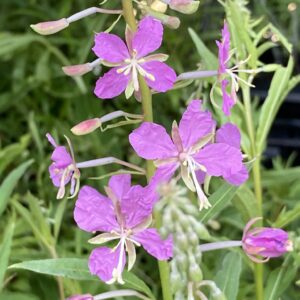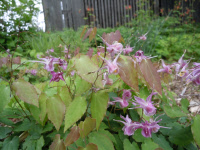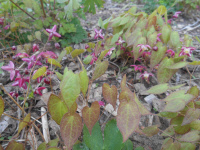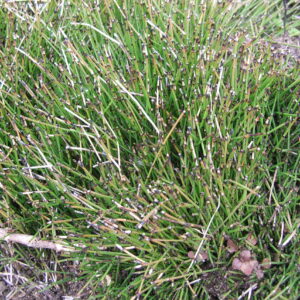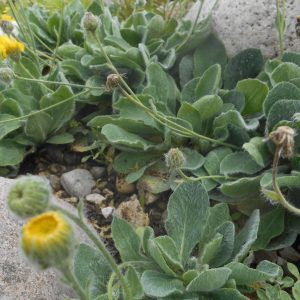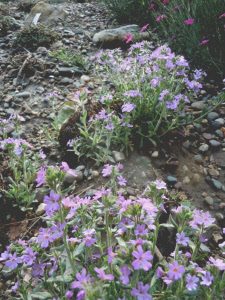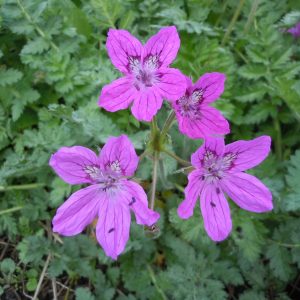Perennials & Biennials
Showing 169–176 of 511 results
-
Epilobium angustifolium syn. Chamaenerion angustifolium Fireweed Z 2-7
Bright pink to lilac purple flowers June-July atop red stems covered in willow-like leaves
OUT OF STOCK
Bright pink to lilac purple flowers June-July atop red stems covered in willow-like leaves
Size: 2-6’ x 3’ spreading
Care: Sun to part shade in dry to moist well drained soil
Native: Circum-polar to the temperate northern hemisphere. Wisconsin native.
Wildlife Value: Attracts hummingbirds, bees, and butterflies. Host for Fireweed Clearwing moth and Nessus Sphinx moth. Fireweed pollen yields a honey so prized that some Canadian beekeepers drive - or even fly - their hives to areas rich in fireweed for the blossoming season.Common name comes from its quick reappearance after a wildfire. Native Americans used fireweed externally for burns and other skin conditions and made a tea for gastro-intestinal and bronchial problems. Its shoots eaten as a vegetable and young leaves added to salads. Described and named in 1753.
**LISTED AS OUT OF STOCK BECAUSE WE DO NOT SHIP THIS ITEM. IT IS AVAILABLE FOR PURCHASE AT OUR RETAIL LOCATION.
-
Epimedium grandiflorum Barrenwort, Bishop’s hat Z 5-8
White-lavender flowers in May atop wiry stems look like fantastical birds with too many wings, or a four-cornered bishop’s hat.
OUT OF STOCK
White-lavender flowers in May atop wiry stems look like fantastical birds with too many wings, or a four-cornered bishop’s hat. Ornamental heart-shaped leaves and red stems.
Size: 6-12” x 18” slow spreader
Care: shade to part shade in well-drained to moist well-drained soil. Once roots established, valuable in dry shade
Native: China, Japan & KoreaIts Chinese name is “Yin Yang Ho” meaning “Licentious goat herb, “ because allegedly an aphrodisiac for goats! In China & Japan thought to remedy impotence, liver ailments & all age related maladies. In Western gardens since 1834.
-
Epimedium x rubrum syn. Epimedium alpinum var. rubrum Red barrenwort Z 4-8
small, star-shaped, rosey-red flowers dance on the ends of wiry-thin stems
OUT OF STOCK
In mid-spring small, star-shaped, rosey-red flowers dance on the ends of wiry-thin stems about one foot high. Red-flushed foliage follows the flowers, the more sun, the more red on leaves. Wonderful groundcover. Cross between Epimedium grandiflorum and Epimedium alpinum
Size: 16” x 24” slow spreading
Care: Sun to shade in most any soil but best in part shade – one of most adaptable plants
Wildlife Value: deer resistant
Awards: Elisabeth Carey Miller Botanic Garden Great Plant Pick1st described in 1853 in Belgique Hort. iii. 33. I. 6.
-
Equisetum scirpoides Dwarf horsetail Z 3-11
Short, bamboo-like - Black bands show joints of green stems, no showy flowers
OUT OF STOCK
Short,bamboo-like – Black bands show joints of green stems, no showy flowers
Size: 6” x spreads – invasive in moist soil if not planted in pots sunk in the ground
Care: full sun, moist to wet soil
Native: all North America – incl. Arctic - north of ILCollected by André Michaux, French planthunter who searched nearly all No. Am. East of the Mississippi for 11 years in mid-1700’s. Contains large amounts of silica, giving it abrasiveness, so used to scrub. Grizzly bears in Pacific Northwest reported to eat Dwarf horsetail.
-
Erigeron aureus Alpine yellow fleabane Z 5-8
White hairs cover frosted-looking basil leaves making this worthy of any garden even without flowers, but then its school bus yellow daisies flower from spring through fall.
OUT OF STOCK
White hairs cover frosted-looking basil leaves making this worthy of any garden even without flowers, but then its school bus yellow daisies flower from spring through fall.
Size: 3-4” x 3”
Care: sun in moist well-drained to well-drained soil
Native: Cascade Mountains from Alberta to State of Washington
Wildlife Value: attracts bees, butterflies and birds1st described in literature in 1884.
-
Erigeron compositus Cutleaf daisy, Dwarf mountain fleabane Z 3-8
Cushion shaped plant with wooly grey leaves topped by small bluish, pink or white rays like a daisy with a yellow center. Flowers in June-July.
OUT OF STOCK – PLEASE EMAIL FOR AVAILABILITY
Cushion shaped, midget plant with wooly grey leaves topped by small bluish, pink or white rays like a daisy with a yellow center. Flowers in June-July.
Size: 6” x 6-12”
Care: sun to part shade in well-drained soil. Drought tolerant.
Native: all of western No. America from prairies to alpine slopes.Erigeron comes from Greek er meaning “spring” and geron for “old man” due to some of these species having white downy hair like an old man.
Thompson Indians from British Columbia chewed on the plant then spit on sores to remedy skin ailments. They also made a decoction of the plant, mixed with any weeds for broken bones. Collected by Meriwether Lewis in late spring 1806 near today’s Lewiston Idaho. -
Erinus alpinus Fairy foxglove, Alpine balsam Z 4-7
May- July violet, pink or white 5-petaled stars, self-sows
OUT OF STOCK
May- July violet, pink or white 5-petaled stars, self-sows
Size: 3” x 4” spreads
Care: sun to part shade in well drained soil
Native: Alps & Pyrenees
Awards: Royal Horticultural Society Award of Garden Merit.Erinus comes from Greek er meaning spring, for the time when this plant blooms. Collected by 1716. Wm. Robinson, father of mixed perennial border, called this a “pretty alpine plant.”
-
Erodium manescavii syn. Erodium manescani Heron’s bill Z. 5-8
Magenta saucer-shaped petals April-November. Seed’s tail like a corkscrew, flings seed as it dries.
Magenta saucer-shaped petals April-November. Seed’s tail like a corkscrew, flings seed as it dries.
Size: 12-18” x 8”
Care: Full sun in well-drained soil
Native: PyreneesErodium is Greek meaning “heron,” because the seed capsule resembles a heron’s head and bill. Collected before 1889. According to William Robinson, father of the mixed perennial border, this is “most showy (and) throws up strong flower stalks…each with 7 to 15 purplish flowers.”

